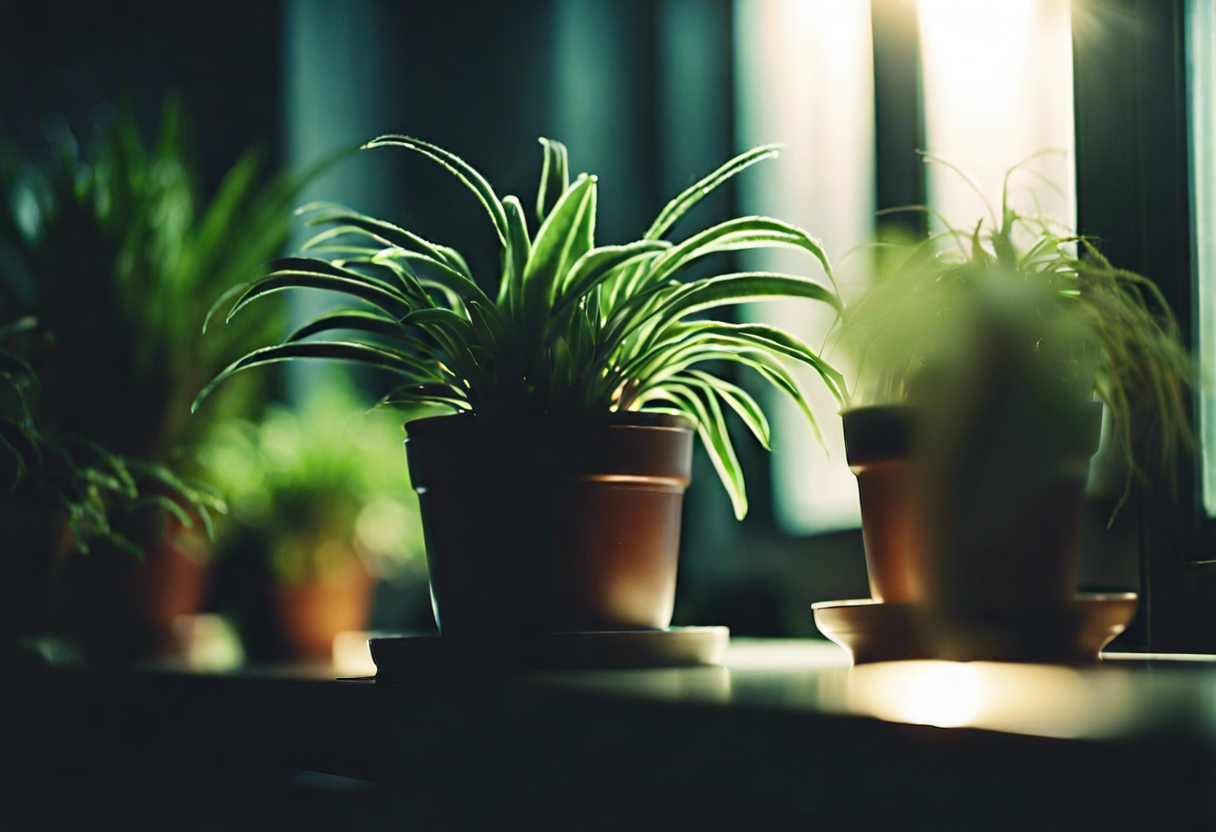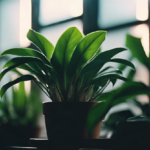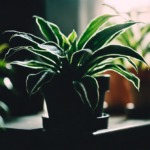The Best Low Light Plants for Indoor Spaces
When it comes to indoor gardening, lighting is often a crucial factor to consider. Not all plants thrive in low light conditions, but fortunately, there are plenty of options available for those looking to add some greenery to their indoor spaces. Low light plants are especially well-suited for rooms with limited natural sunlight, such as north-facing windows or offices with few windows. Here are some of the best low light plants to consider:
-
Snake Plant (Sansevieria trifasciata): Known for its air-purifying properties, the snake plant is a popular choice for low light environments. It can tolerate a wide range of light conditions, making it a versatile option for any room. The snake plant has striking, tall leaves that add visual interest to any space.
-
ZZ Plant (Zamioculcas zamiifolia): The ZZ plant is known for its glossy, dark green leaves that can brighten up even the darkest corners of a room. It is a drought-tolerant plant, making it perfect for those who may forget to water their plants regularly. The ZZ plant is also known for its ability to remove toxins from the air.
-
Pothos (Epipremnum aureum): Pothos is a trailing plant that is easy to care for and can thrive in low light conditions. Its heart-shaped leaves come in a variety of colors, including green, golden, and variegated. Pothos can be grown in hanging baskets or trained to climb up walls or trellises, adding a touch of greenery to vertical spaces.
-
Peace Lily (Spathiphyllum): The peace lily is not only a beautiful plant, but also an excellent air purifier. It produces white, spoon-shaped flowers that can add a pop of color to any room. The peace lily prefers low light conditions and can even thrive in rooms with fluorescent lighting.
-
Dracaena (Dracaena spp.): With its slender, arching leaves and various leaf patterns, the dracaena is a visually striking plant that can tolerate low light conditions. There are many different species and cultivars of dracaena to choose from, each with its own unique leaf shape and color.
-
Chinese Evergreen (Aglaonema): Chinese evergreen is a popular choice for low light environments due to its ability to thrive in indirect light. It has attractive, variegated leaves that come in a range of colors, including green, silver, and red. Chinese evergreen is also known for its air-purifying qualities.
-
Cast Iron Plant (Aspidistra elatior): As the name suggests, the cast iron plant is incredibly tough and resilient. It can tolerate low light conditions, as well as neglect and drought. Its dark green, strappy leaves make it an attractive addition to any indoor space.
When selecting low light plants for your indoor spaces, it’s important to consider factors such as the amount of natural light available, the plant’s water and humidity requirements, and your own gardening skills and preferences. With the right choice of low light plants, you can create a lush and inviting indoor garden, even in spaces with limited sunlight.
Tips for Selecting and Caring for Low Light Plants
When it comes to adding greenery to indoor spaces, low light plants are an excellent choice. These plants are well-suited for areas with limited access to natural sunlight, making them perfect for offices, apartments, or rooms with few windows. If you’re considering incorporating low light plants into your indoor space, here are some essential tips for selecting and caring for them.
1. Assess your lighting conditions: Before selecting any low light plants, it’s essential to evaluate the lighting conditions in your indoor space. Low light plants thrive in areas where sunlight is minimal or indirect, such as north-facing windows or rooms with artificial lighting. Understanding your lighting conditions will help you choose the right plants that can adapt and thrive in your environment.
2. Choose low light tolerant plants: When selecting low light plants, look for varieties known for their ability to thrive in low light conditions. Some popular options include snake plants, pothos, ZZ plants, and peace lilies. These plants have adapted to environments with less sunlight and can still flourish in your indoor space.
3. Consider plant size and growth habit: Before bringing a low light plant home, consider its eventual size and growth habit. Determine whether you have enough space for the plant to grow and whether it will fit nicely in your chosen spot. Some low light plants, like pothos, have trailing foliage, making them perfect for hanging planters or shelving units.
4. Provide proper watering: Low light plants typically require less water compared to their sun-loving counterparts. Overwatering can lead to root rot and other problems. As a general rule, water your low light plants when the top inch of soil feels dry. Remember to use well-draining pots and avoid letting the plants sit in standing water.
5. Use suitable potting mix: Opt for a well-draining potting mix that allows water to evenly distribute throughout the container. A good potting mix will prevent waterlogging while providing essential nutrients to your low light plants. Avoid using heavy soils or those designed for outdoor use, as they may retain too much water.
6. Dust and clean foliage: Dust can accumulate on the foliage of low light plants, hindering their ability to photosynthesize. Regularly wipe the leaves with a damp cloth or gently spray them with water to keep them clean and free from dust. This will help the plants thrive and maintain their vibrant appearance.
Low light plants into your indoor space can bring a touch of nature and beauty to any room. By following these tips for selecting and caring for low light plants, you can create a green oasis even in areas with limited sunlight. Remember to choose suitable plants, provide proper care, and enjoy the calming benefits of indoor greenery.
Styling Ideas for Low Light Plants in Interior Design
Low light plants are a great way to add greenery and life to indoor spaces that receive limited sunlight. With their ability to thrive in shaded areas, low light plants have become increasingly popular in interior design. They not only purify the air but also create a calming and inviting ambiance. Here are some styling ideas to incorporate low light plants into your interior design:
1. Create a Focal Point
One way to incorporate low light plants into your interior design is by creating a focal point. Choose a larger low light plant, such as a peace lily or a snake plant, and place it in a prominent spot in the room. Use an attractive pot or planter to complement the overall theme of your space. By placing the plant in a central location, you draw attention to its beauty and make it a standout element in your interior design.
2. Vertical Gardens
If you have limited floor space, consider creating a vertical garden using low light plants. Hang macrame planters or install wall-mounted shelves to display a collection of low light plants. This not only maximizes space but also adds visual interest to your walls. Choose a variety of low light plants with different leaf shapes and textures to create a stunning display of cascading foliage.
3. Mix and Match
Experiment with different low light plants that have varying heights, leaf colors, and textures. Mix and match plant varieties to create an eclectic and layered look. Combine plants like pothos, ferns, and ZZ plants to add visual diversity to your space. Remember to consider the pot or planter colors and materials to ensure they blend harmoniously with your overall interior design scheme.
4. Hanging Planters
Another stylish way to incorporate low light plants is by using hanging planters. Macrame plant hangers or ceiling-mounted hooks can be used to suspend plants from the ceiling. Hang plants like spider plants or Boston ferns to add a whimsical touch to your interior design. This not only saves floor space but also draws the eye upwards, making your space feel larger and more dynamic.
5. Terrariums
Low light plants are well-suited for terrariums, which are glass containers that create a mini-ecosystem for your plants. You can use closed or open terrariums depending on the plant’s humidity requirements. Create an enchanting display by combining different types of low light plants, moss, rocks, and other decorative elements. These miniature gardens add charm and a touch of nature to your interior design.
Low light plants into your interior design adds a touch of nature and freshness to your space. Whether you choose to create a focal point, embrace vertical gardens, mix and match different plant varieties, use hanging planters, or explore terrariums, there are endless styling possibilities. With the right combinations and placements, you can transform your indoor spaces into green sanctuaries that thrive in low light conditions.
Benefits of Having Low Light Plants Indoors
Having indoor plants not only adds beauty to your space but also offers various benefits for your well-being. Low light plants, in particular, are an excellent choice for those areas in your home where natural sunlight is limited. Let’s explore the benefits of having low light plants indoors and why they are a perfect addition to your interior.
1. Improved Air Quality: Low light plants are known to be excellent air purifiers. They absorb carbon dioxide and release oxygen during the process of photosynthesis. Additionally, they remove harmful toxins, such as formaldehyde and benzene, from the air. This can improve the air quality in your home and promote a healthier living environment.
2. Stress Reduction: Studies have shown that interacting with nature, even indoors, can help reduce stress levels. Low light plants create a calming and soothing atmosphere, providing a sense of tranquility and relaxation. Their presence can help create a peaceful ambiance, making your indoor space a more serene and tranquil retreat.
3. Increased Productivity and Concentration: Having low light plants in your workspace or study area can enhance productivity and concentration. Research suggests that plants in the workspace can improve focus and attention span, leading to better work performance. Their green foliage can also help reduce eye strain caused by constant screen exposure.
4. Natural Humidifiers: Indoor environments often lack humidity, especially during the winter months. Low light plants release moisture through a process called transpiration, increasing the humidity levels in your home naturally. This can alleviate dry skin, dry throat, and other discomforts commonly associated with dry indoor air.
5. Biophilic Connection: Humans have an innate connection with nature, known as biophilia. Having low light plants indoors allows us to bring a piece of the natural world into our homes. This biophilic connection can have a positive impact on our mental and emotional well-being, promoting feelings of happiness and contentment.
6. Aesthetically Pleasing: Low light plants come in a wide variety of shapes, sizes, and textures, making them visually appealing additions to your interior. Whether you prefer cascading vines, broad-leaved foliage, or miniature succulents, there is a low light plant that will complement your decor and personal style.
Having low light plants indoors offers numerous benefits, ranging from improved air quality and stress reduction to increased productivity and aesthetic appeal. Consider adding a few low light plants to your home to enjoy these advantages and create a welcoming and beautiful environment.
Common Mistakes to Avoid When Growing Low Light Plants Inside
Low light plants are a popular choice for indoor spaces due to their ability to thrive in areas with limited sunlight. However, there are some common mistakes that people make when growing these plants indoors. By avoiding these pitfalls, you can ensure that your low light plants not only survive but thrive in your home or office environment.
1. Overwatering: One of the biggest mistakes people make with low light plants is overwatering. These plants typically have lower water requirements compared to their sun-loving counterparts. It’s important to let the top inch or so of the soil dry out before watering again. Overwatering can lead to root rot and other fungal issues.
2. Choosing the Wrong Plant: Not all low light plants are created equal. Some plants, such as Peace Lily and Snake Plant, are better suited for low light conditions than others. Before purchasing a plant, do some research to find out its light requirements. Choosing the right plant for your specific indoor environment will increase its chances of thriving.
3. Lack of Proper Drainage: Adequate drainage is essential for the health of low light plants. Without proper drainage, excess water can accumulate in the soil and lead to root rot. Make sure your pots have drainage holes and use a well-draining potting mix.
4. Ignoring Pest Control: Just because low light plants are indoors doesn’t mean they are immune to pests. Common pests, such as spider mites and aphids, can still infest these plants. Regularly inspect your plants for signs of pests and take appropriate measures to control them.
5. Neglecting to Rotate: Low light plants tend to grow towards the light source. To ensure even growth, it’s important to regularly rotate your plants. This will help prevent your plants from leaning or becoming lopsided.
6. Failing to Provide Adequate Humidity: Many low light plants thrive in humid environments. To mimic their natural habitat, consider increasing humidity levels by using a humidifier or placing a tray of water near your plants. This will help prevent dryness and keep your plants healthy.
7. Using the Wrong Fertilizer: Low light plants have lower nutrient requirements compared to sun-loving plants. Using a heavy-handed approach with fertilizers can lead to nutrient burn or excessive growth. Use a balanced, diluted fertilizer specifically formulated for indoor plants, and follow the manufacturer’s instructions.
8. Not Cleaning the Leaves: Dust can accumulate on the leaves of low light plants, which can hinder their ability to photosynthesize. Regularly dust or wipe the leaves with a soft cloth to remove any build-up and allow your plants to absorb light more efficiently.
By avoiding these common mistakes, you can ensure that your low light plants not only survive but thrive in your indoor spaces. Remember to choose the right plants, provide proper care, and monitor them regularly to keep them healthy and beautiful.
Conclusion
Low light plants into your indoor spaces can bring a touch of nature and enhance the aesthetics of your interior design. With their ability to thrive in minimal lighting conditions, these plants offer a versatile and practical option for those areas where natural light is limited. This article has explored the best low light plants for indoor spaces, provided tips for selecting and caring for them, offered styling ideas for incorporating them into interior design, highlighted the benefits of having these plants indoors, and discussed common mistakes to avoid when growing them inside.
When it comes to choosing low light plants for your indoor spaces, there are several options available. Some popular choices include the snake plant, pothos, ZZ plant, peace lily, and dracaena. These plants not only tolerate low light but also have air-purifying properties, making them ideal for improving indoor air quality.
To ensure that your low light plants thrive, it is important to select ones that are suitable for the specific lighting conditions in your space. Consider factors such as the direction of natural light and the intensity of artificial light sources. Additionally, pay attention to the watering needs, soil requirements, and temperature preferences of each plant to fully support their growth and overall health.
Low light plants into your interior design can create an inviting and vibrant atmosphere. Consider placing them in decorative planters and arranging them in clusters or as standalone pieces. You can also experiment with different sizes and heights to provide visual interest and depth to the space. Hang trailing plants from shelves or ceiling hooks to add an element of whimsy and make use of vertical space.
Having low light plants indoors offers numerous benefits beyond just their aesthetic appeal. These plants can increase humidity levels, which is beneficial for both your respiratory health and the longevity of wooden furniture. They also help to reduce stress, boost mood, and enhance productivity, making them an ideal addition to workspaces and study areas.
While low light plants are relatively low maintenance, there are some common mistakes to avoid to ensure their successful growth. One mistake is overwatering, as most low light plants prefer slightly dry soil. It’s important to monitor the moisture levels and water them only when the top inch of soil is dry to the touch. Another mistake is placing low light plants in direct sunlight, as this can cause their leaves to burn. avoid using cold water on these plants, as they are sensitive to temperature changes and prefer lukewarm water.
Low light plants are excellent options for indoor spaces with limited natural light. They not only bring a touch of nature into your home or office but also offer a range of benefits for your well-being. By selecting suitable plants and providing proper care, you can enjoy the beauty and benefits of low light plants while enhancing the overall aesthetics of your space.


